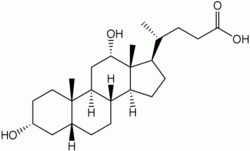- Deoxycholic acid
-
Deoxycholic acid  (3α,5β,12α,20R)-3,12-dihydroxycholan-24-oic acidOther namesDeoxycholic acid
(3α,5β,12α,20R)-3,12-dihydroxycholan-24-oic acidOther namesDeoxycholic acid
DeoxycholateIdentifiers CAS number 83-44-3 
PubChem 222528 ChemSpider 193196 
UNII 005990WHZZ 
DrugBank DB07690 ChEBI CHEBI:28834 
ChEMBL CHEMBL406393 
Jmol-3D images Image 1 - C[C@H](CCC(=O)O)[C@H]1CC[C@@H]2[C@@]1([C@H](C[C@H]3[C@H]2CC[C@H]4[C@@]3(CC[C@H](C4)O)C)O)C
- InChI=1S/C24H40O4/c1-14(4-9-22(27)28)18-7-8-19-17-6-5-15-12-16(25)10-11-23(15,2)20(17)13-21(26)24(18,19)3/h14-21,25-26H,4-13H2,1-3H3,(H,27,28)/t14-,15-,16-,17+,18-,19+,20+,21+,23+,24-/m1/s1

Key: KXGVEGMKQFWNSR-LLQZFEROSA-N
InChI=1/C24H40O4/c1-14(4-9-22(27)28)18-7-8-19-17-6-5-15-12-16(25)10-11-23(15,2)20(17)13-21(26)24(18,19)3/h14-21,25-26H,4-13H2,1-3H3,(H,27,28)/t14-,15-,16-,17+,18-,19+,20+,21+,23+,24-/m1/s1
Key: KXGVEGMKQFWNSR-LLQZFEROBK
Properties Molecular formula C24H40O4 Molar mass 392.57 g mol−1 Density ? g/cm3 Melting point 174 - 176 °C
Acidity (pKa) 6.58[1]  (verify) (what is:
(verify) (what is:  /
/ ?)
?)
Except where noted otherwise, data are given for materials in their standard state (at 25 °C, 100 kPa)Infobox references Deoxycholic acid, also known as deoxycholate, cholanoic acid, and 3α,12α-dihydroxy-5β-cholanate, is a bile acid. Deoxycholic acid is one of the secondary bile acids, which are metabolic byproducts of intestinal bacteria. The two primary bile acids secreted by the liver are cholic acid and chenodeoxycholic acid. Bacteria metabolize chenodeoxycholic acid into the secondary bile acid lithocholic acid, and they metabolize cholic acid into deoxycholic acid. There are additional secondary bile acids, such as ursodeoxycholic acid. Deoxycholic acid is soluble in alcohol and acetic acid. When pure, it comes in a white to off-white crystalline powder form.
Contents
Applications
Deoxycholic acid has been used since its discovery in various fields of human medicine. In the human body deoxycholic acid is used in the emulsification of fats for the absorption in the intestine. It has, in some countries (including Switzerland) been licensed as an emulsifier in food industry,[2] but it is no longer common. Outside the body it is used in experimental basis of cholagogues and is also in use to prevent and dissolve gallstones.[3][4]
Sodium deoxycholate, the sodium salt of deoxycholic acid, is frequently used in mesotherapy injections, mixed with phosphatidylcholine.[citation needed]
In research deoxycholic acid is used as a mild detergent for the isolation of membrane associated proteins. The critical micelle concentration for deoxycholic acid is approximately 2.4-4 mM.[5]
Sodium deoxycholate, the sodium salt of deoxycholic acid, is often used as a biological detergent to lyse cells and solubilise cellular and membrane components.[6]
Deoxycholates and bile acid derivatives in general are actively being studied as structures for incorporation in nanotechnology.[7] They also have found application in microlithography as photoresistant components.[8][9]
Research in immunology
Its function as a detergent and isolating agent for membrane proteins also suits it for production of Outer Membrane Protein (OMP) vaccines such as MenB, a Norwegian vaccine developed in the early 1990's[10]. The MeNZB vaccine was produced using the same method[11].
In China, the traditional medicine "Niuhuang", which in Chinese means "Oxen Yellow" and is actually bilestone of oxen, has been in use for two millennia in the unproven belief that it treats inflammations and enhances the immune system.[12] One of its main components is DCA.
Some European publications point towards the effect of DCA as an immunostimulant[13][14] of the unspecific immune system, activating its main actors, the macrophages. According to these publications, a sufficient amount of DCA in the human body would correspond with a good immune reaction of the unspecific immune system. Clinical studies conducted in the 1970s and 1980s confirm the expectation, that DCA is involved in the natural healing processes of local inflammations,[15][16] different types of herpes,[17][18] and possibly cancer.[19][20]
See also
- Ursodiol (ursodeoxycholic acid)
- Bile acids
References
- ^ Lide, David R. (1998). Handbook of Chemistry and Physics (87 ed.). Boca Raton, FL: CRC Press. pp. 1287. ISBN 0-8493-0594-2
- ^ Streuli, H. et. al.: SLMB - Schweizer Lebensmittelbuch, 1992, chapter 58, 4/3
- ^ Combichole, Trout Medical Inc., Houston, US
- ^ Cholecysmon, Riemser Arzneimittel AG, Riems, Germany
- ^ J.M. Neugebauer, Detergents: An Overview, in: M.P. Deutscher, Guide to Protein Purification (Methods in Enzymology Vol. 182), Academic Press, San Diego 1990
- ^ Sodium deoxycholate
- ^ Molecules, 2001, 6, 21.
- ^ Polym. Mat. Sci. Eng., 1997, 77, 445.
- ^ Chemistry Letters, 2000, 414.
- ^ Fredriksen JH, Rosenqvist E, Wedege E, et al. (December 1991). "Production, characterization and control of MenB-vaccine "Folkehelsa": an outer membrane vesicle vaccine against group B meningococcal disease". NIPH Ann 14 (2): 67–79; discussion 79–80. PMID 1812438.
- ^ eg, see PR from NZ immunology group, http://www.scoop.co.nz/stories/GE0506/S00048.htm
- ^ Chen X, Mellon RD, Yang L, Dong H, Oppenheim JJ, Howard OM. (The Laboratory of Molecular Immunoregulation, Center for Cancer Research, National Cancer Institute-Frederick, Bldg. 560, Rm. 31-19, Frederick, MD 21702-1201, USA): Regulatory effects of deoxycholic acid, a component of the anti-inflammatory traditional Chinese medicine Niuhuang, on human leukocyte response to chemoattractants. Biochemical Pharmacology 2002, 63(3), 533-541.
- ^ Vlček B.: Potentiation of the immune response with DCA (czech), Prakt.Lekar 52, 326-330 (1972)
- ^ Chyle M., Chyle P.: Regulation of the immune response with DCA (czech, engl. summary), Sbornik lek. 84, 212-218 (1982)
- ^ Vlček B.: Deoxycholic acid as a potential cancerostatic and antiviral factor, Advances in Antimicrobial and Antineoplastic Chemotherapy, Vol. II/1, p.145-147 (Urban & Schwarzenberg, München 1972
- ^ Chyle M., Chyle P., Dolezal V. (Inst. f. hygiene and epidemiology, Prag): Deoxycholic acid – Therapy of viral infections and a toxicological inquiry 2nd Symp. on Prevention and Treatment of Viral Infections, Bechyne Castle 1988, p. 56f.
- ^ Chyle M. (Universität Prag), Chyle P.: Deoxycholic acid in therapy of herpes labialis (czech, engl. summary), Cas. Lek. ces. 114, 1226–1229 (1975)
- ^ Bradna J. (Poliklinik, Kutna Hora): Treatment of herpes zoster with deoxycholic acid (czech, engl. summary), Rehabilitacia (Bratislava) 16, 77-86 (1983)
- ^ Vlček B., Reif A., Budsky F. (Inst. f. Strahlenhygiene, Prag): Toxicity of deoxycholate at pH below 7,3 as a potential cancerostatic property, Experientia 26, 776-778 (1970)
- ^ Vlček B., Reif A., Seidlova B.: Evidence of the participation of deoxycholate in cancer immunity, Z.Naturforsch. 26 b, 419-424 (1971)
External links
Categories:- Bile acids
- Microbiological media ingredients
Wikimedia Foundation. 2010.
